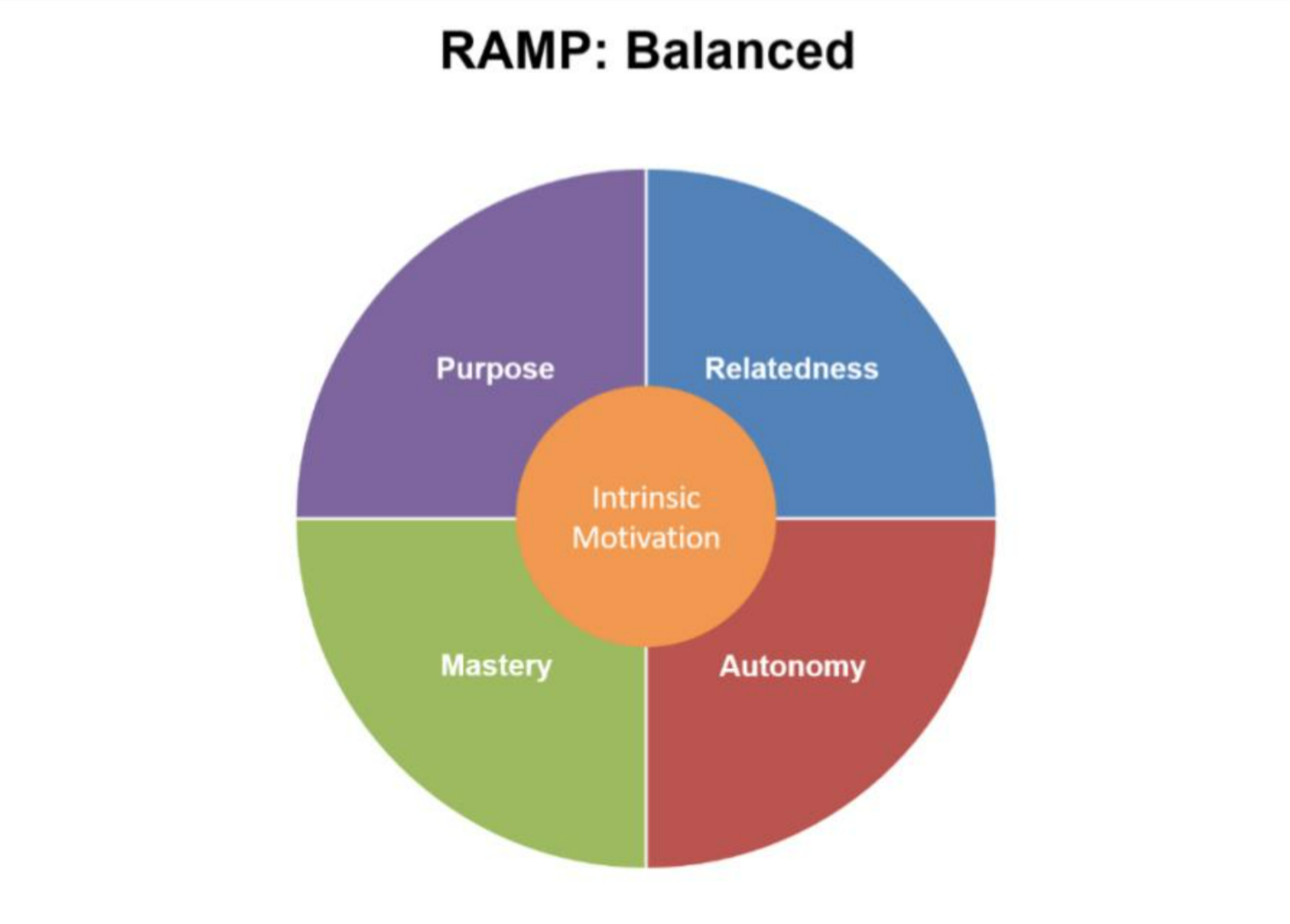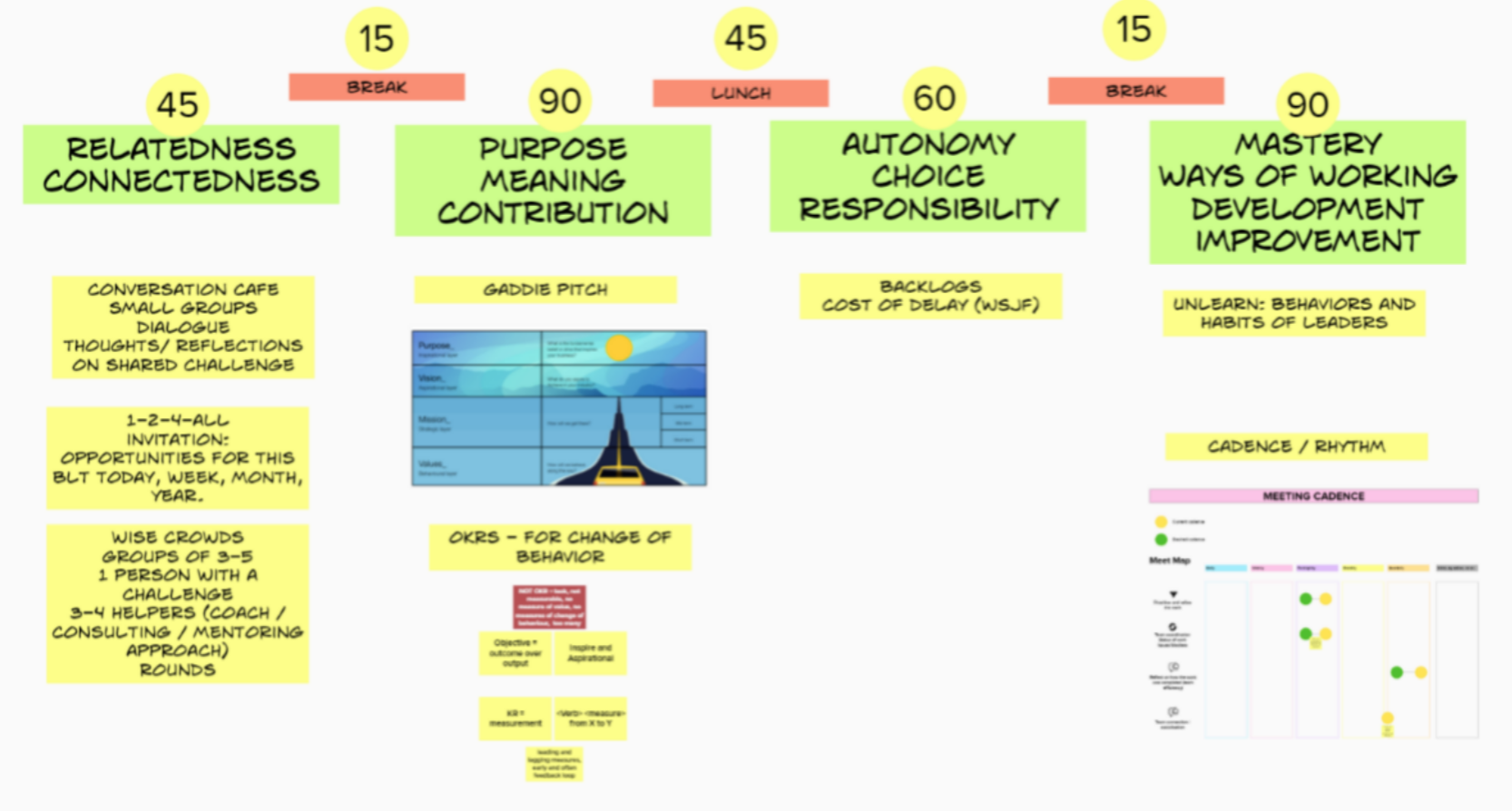
Designing a leadership offsite workshop using the RAMP approach
When I was asked to come up with some ideas for designing a leadership team’s offsite all day workshop, I approached the situation by framing the event as an engagement challenge.
How might we tap into the fundamental intrinsic motivators that lead to engagement?
What are the core needs of the people that I need to serve as a facilitator?
Now, is engagement the only frame I could have used for this challenge? Nope. There are other agendas at play, including organisational agility, strategy coaching plans and transformational change drivers.
A RAMP to engagement
A useful model to frame engagement that I like to use is RAMP – Relatedness, Autonomy, Mastery and Purpose. Based upon the Self-determination Theory of Deci and Ryan, alongside Dank Pink’s Drive, a deep body of research shows that people are essentially motivated by a combination of RAMP, with situational shifts and individual variance in weights to each.
So what is RAMP?
Relatedness is about belonging and being connected to other people in relationships. The need to be social creatures is engrained in us from our tribal origins 200,000 year ago.
Autonomy is about choice and freedom – with a corresponding sense of responsibility and control over how one works.
Mastery is about improvement and becoming more skilled when facing a challenge – not too easy (boring!) and not too hard (impossible!).
Purpose is about our need to find meaning in what we do – there is a greater reason and a benefit to a larger entity than ourselves

Where to start?
In agile ways of working, the team is the smallest unit that creates value in an organisation. Therefore, for the first activity I embrace relatedness (think connection) as the first motivator. To strengthen social networking, I look to liberating structures to help build social connections fast!
Some useful options for connecting include:
- Impromptu Networking
- Conversation Café
- 1-2-4-ALL
- Wise Crowds
Go here to learn more about these useful techniques/practices. Liberating Structure menu: https://www.liberatingstructures.com/ls/
As Simon Sinek says, Start With Why?
Second step is to connect Purpose to strategy. For people to feel that their contribution matters there needs to be a ‘north star’ – a direction that we’re headed. This is the fundamental drive that inspires your group.
A key activity to do here is the Vision statement – why you do what you do? What do you aspire to achieve?
You might be able to look at your Mission (strategy) – “how will we get there?” Short-term, mid-term, long-term. In order to connect Purpose, Vision, Mission, I have used the Gaddie Pitch to help groups write their purpose, and combined this technique with Objectives and Key Results (OKRs) – my how to here: https://www.linkedin.com/pulse/next-level-okrs-power-pitch-daniel-hill/
Freedom!
This leads to autonomy. A fundamental approach to agility involves the ordered backlog – where items of value (pieces of work) are prioritised. The cost of delay model is a great way to price or think about items economically – where you must make decisions and choose where to start based on not only value but the size of the job. Cost of delay divided by duration (CD3) is an avenue to get your group to take responsibility for the choices they need to make.
Getter better at Getting better.
The final element is mastery. In this space I focus on growth and development in individuals and teams, as well as improving ways of working. I tap into personal development and self-reflection with an exercise on Unlearning behaviours and habits. I add in an activity to experiment with meeting cadence and effectiveness as a team growth improvement opportunity.
Early design sketch of the workshop with RAMP frame:

Benefits and Impacts
Framing an offsite event using RAMP is an attempt to approach the problem of building an agenda that is more engaging and motivating for attendees. You also need to consider your own style as a facilitator and the personal bias you might bring.
Tapping into intrinsic motivation through RAMP might give you buy-in from participants to pay attention and be willing to go through a little discomfort to grow or change. You might never get to the ‘groan zone’ (where participants deeply learn through collectively experiencing discomfort) if your workshop is so dull that participants are daydreaming or going through the motions.
Why not try to incorporate RAMP framing in the design of your next workshop?
Framing: https://stevepavlina.com/blog/2022/03/why-i-love-to-think-in-terms-of-frames/
Hat tip to Andrzej Marczewski for RAMP: https://www.gamified.uk/gamification-framework/the-intrinsic-motivation-ramp/
Unlearning for C suite: https://www.linkedin.com/pulse/learning-unlearn-foundational-skill-c-suite-help-enable-dowling/
Groan Zone’: Kaner, S., Lind, L., Toldi, C., Fisk, S., & Berger, D. (2007). Facilitator’s Guide to Participatory Decision-Making (2nd ed., p. 363).
Author - Daniel Hill


